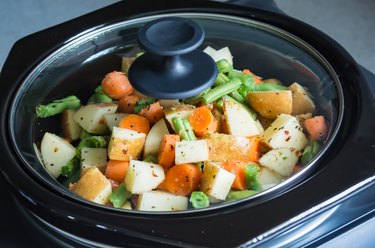
If you're considering using a crock-pot to reheat food, you should rethink that plan due to food safety concerns, advises the Mayo Clinic. Slow cookers might not get food hot enough to kill any resident bacteria. Instead, reheat leftovers on the stovetop, or use a microwave or conventional oven.
Temperatures and Cooking Times
Video of the Day
If you never seem to have time to cook meals at home, try using a versatile slow cooker. Besides the time and convenience factor, a slow cooker also consumes less power than a conventional oven, notes the USDA.
Video of the Day
A low-temperature slow cooker enables leaner, less expensive meat cuts to become more tender. The cooker's direct heat and long cooking cycle also help to destroy potentially harmful food-borne bacteria.
To heat your slow cooker to the proper temperature, focus on the device's simmer point. This is when your slow cooker contents have reached 209 degrees Fahrenheit, just under the boiling point. On the slow cooker's low setting, reaching the simmer point should take between seven and eight hours. It should take about three to four hours on a high setting.
If you'd rather not leave the slow cooker running while you're away from home, set the timer to cook your food while you're there, suggests PennState Extension. Or, set the timer to cook the food overnight, but stick to the recommended cooking time.
Slow Cooker Food Safety Tips
To minimize the risk of food-borne illness, follow recognized food safety guidelines, recommends the USDA. Before beginning your meal prep, ensure that your work area, slow cooker, cutting board and utensils are clean.
Defrost your meat or poultry, and cut it into smaller pieces, before scooping it into the slow cooker. Frozen proteins take excessive thawing time, giving bacteria free reign to multiply and possibly make you sick. Defrosted foods are also more likely to cook thoroughly.
Warning
Never put frozen meat or poultry in a slow cooker. Frozen proteins won't cook properly, and that can encourage food-borne bacteria growth.
Keep other perishable foods refrigerated until the last minute. Just before you cover the slow cooker, confirm that the device is at least half, but less than two-thirds, full. This food volume ensures that your meal will be thoroughly cooked.
While cooking your meal, only remove the slow cooker lid to stir the food or verify that it's done, recommends the Academy of Nutrition and Dietetics. Repeatedly lifting the lid affects the pot's ability to retain heat and completely cook the food. Use a food thermometer to confirm that the food has finished cooking and is safe to consume.
Using a Crock-Pot to Reheat Food
Reheating leftovers gives you a chance to enjoy a tasty meal a second (or third) time, but using a crock-pot to reheat food isn't the best solution.
The Mayo Clinic stresses that a slow cooker doesn't produce enough heat to kill bacteria lurking in the food. Cook the leftovers on the stovetop, or use a conventional oven or microwave.
You also shouldn't complete the initial cooking cycle on the slow cooker's "Warm" setting, advises the University of Minnesota Extension. Instead, closely follow the recipe's higher-heat cooking directions. After your food is cooked, serve it immediately rather than letting it cool down in the slow cooker.
Best Way to Reheat Stew
Given that guidance, what's the best way to reheat stew? As the University of Wisconsin-Madison explains, the key to safely reheating leftovers is to ensure that they reach 165 degrees F on a food thermometer.
The best way to reheat stew, soups, gravies and sauces is to heat them to a rolling boil. Cover the food to ensure even heating and retain the dish's moisture.
Although the stovetop may provide the best way to reheat stew, warming the food in a microwave is also an option. For even heating, cover a microwave-safe ceramic or glass dish, and let the steam escape through a vent. The moist heat will eradicate the resident bacteria and help the food to cook evenly.
When you're reheating food for potluck meals, you may have doubled or tripled the recipe, so there's considerably more food to heat. Always allow sufficient heating time before serving.
- Mayo Clinic: "How Long Can You Safely Keep Leftovers in the Refrigerator?"
- USDA: "Cook Slow to Save Time: Four Important Slow Cooker Food Safety Tips"
- PennState Extension: "The Benefits of Slow Cooker Meals"
- Academy of Nutrition and Dietetics: "10 Food Safety Tips for the Slow Cooker"
- University of Minnesota Extension: "Slow Cookers and Food Safety"
- University of Wisconsin-Madison: "Leftovers and Food Safety"